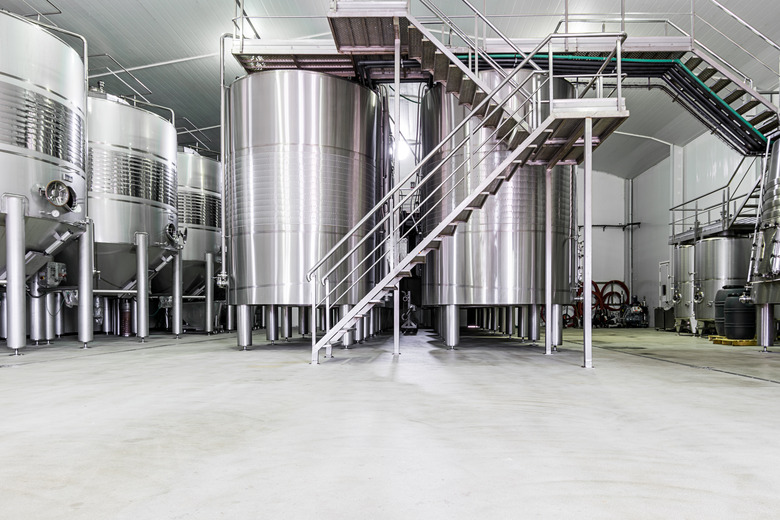How To Figure The Weight Of A Steel Tank
The weight of any object is related to its weight density and volume. The weight density of steel commonly used in industrial tanks is 490 pounds per cubic foot. To determine the volume, or amount of space taken up by the steel, you need to calculate the surface area and thickness of the tank.
Step 1
Measure the height, thickness and radius of the steel tank in inches. Measure the radius on the top or bottom surface of the tank from the center of the circle to its edge in a straight line. As an illustration assume a height of 62.0 inches, a thickness of 1.0 inches and a radius of 20.0 inches.
Step 2
Convert each measurement to feet by dividing by 12, since each foot contains 12 inches. Performing this step leads to a height of 5.17 feet, a thickness of 0.083 feet and a radius of 1.67 feet.
Step 3
Calculate the surface area, in square feet, of the tank's side wall. This is done by multiplying 2 by the value of pi and multiplying that answer by the radius times the height. Use 3.14 for the number pi. Multiplying 2 by 3.14 produces an answer of 6.28. When this is multiplied by 1.67, it produces an answer of 10.48. When that is multiplied by 5.17, it produces a total surface area of 54.22 square feet.
Step 4
Determine the area of the top and bottom of the tank by multiplying 2 times pi times the radius squared. This comes from the fact that the area of a circle is pi times radius squared, and there are two circles of equal size. This process leads to a value of 6.28 (2*3.14). The radius in this example is 1.67 feet. When squared, it produces a total of 2.78. When 6.28 is multiplied by 2.78, it produces an answer of 17.51 square feet.
Step 5
Add the surface area of the side walls to the area of the top and bottom to get the total area in square feet. For this step, 54.22 square feet is added to 17.51 square feet to get an answer of 71.73 square feet.
Step 6
Multiply the total area by the tank's thickness to obtain the volume in cubic feet of the steel. In this step, 71.73 square feet is multiplied by 0.083 feet, which yields a volume of 5.95 cubic feet.
Step 7
Multiply the volume by the weight density of steel to obtain the weight of the steel tank in pounds. Completing the exercise you have 5.95 cubic feet times 490 pounds per cubic foot which equals 2,915 pounds.
Things Needed
- Tape measure
- Calculator
References
- HyperPhysics at Georgia State University: Density
- "Physics for Scientists and Engineers with Modern Physics"; Raymond A. Serway and John W. Jewett; 2009
- Wolfram MathWorld: Cylinder
- Wolfram MathWorld: Circle
Cite This Article
MLA
Hirsch, William. "How To Figure The Weight Of A Steel Tank" sciencing.com, https://www.sciencing.com/figure-weight-steel-tank-7323725/. 13 March 2018.
APA
Hirsch, William. (2018, March 13). How To Figure The Weight Of A Steel Tank. sciencing.com. Retrieved from https://www.sciencing.com/figure-weight-steel-tank-7323725/
Chicago
Hirsch, William. How To Figure The Weight Of A Steel Tank last modified March 24, 2022. https://www.sciencing.com/figure-weight-steel-tank-7323725/
